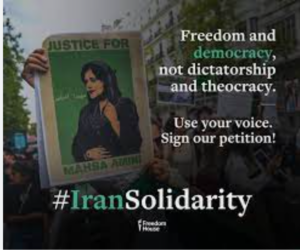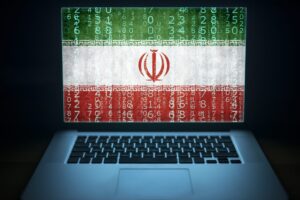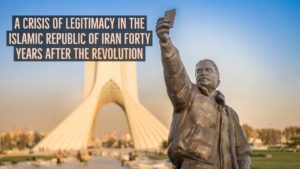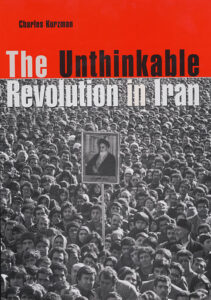While Iran’s civil unrest has diminished, the economic hardship for millions of Iranians continues to deteriorate, The Financial Times reports:
The rial has lost more than a third of its value this year, while inflation soared to 47.7 per cent last month. Against this tough economic background, the Islamic republic believes its enemies — western states such as the US and opposition groups abroad — are using a mix of conventional and unconventional methods, including information, to overthrow the regime in Tehran.
“Authorities know that the street protests are over only on the surface,” said an analyst, who wished to remain anonymous. “The economy is feared to be the next trigger. They want to control the information dissemination to foil that threat.”
 This year’s budget did not increase welfare payments to match inflation, according to analysts, or increase subsidies for food staples and gasoline. The budget did, however, allocate more money to the Revolutionary Guards force and other defense sectors, The New York Times adds.
This year’s budget did not increase welfare payments to match inflation, according to analysts, or increase subsidies for food staples and gasoline. The budget did, however, allocate more money to the Revolutionary Guards force and other defense sectors, The New York Times adds.
“It’s just more money for the defense industry and cuts for the people,” said Henry Rome, a senior fellow at the Washington Institute for Near East Policy who studies Iran, “and I think that kind of speaks for itself.”
An ‘unknown’ virus has poisoned more than 900 girls across 50 schools in various Iranian cities, leaving health experts shell-shocked, TimesNow reports (above). As the incident garnered attention, speculations arise over a possible ‘revenge attack’ by extreme Islamists on Iranian girls.
 When the protests broke out, authorities blocked access to Instagram and WhatsApp. But so many Iranians have VPNs that Meta was able to report last month that hashtags related to the demonstrations had been used more than 160mn times on Instagram. State television still pumps out propaganda but many Iranians have VPN (virtual private network) software, which allows them to circumvent restrictions on the internet and social media apps, The FT’s Najmeh Bozorgmehr adds:
When the protests broke out, authorities blocked access to Instagram and WhatsApp. But so many Iranians have VPNs that Meta was able to report last month that hashtags related to the demonstrations had been used more than 160mn times on Instagram. State television still pumps out propaganda but many Iranians have VPN (virtual private network) software, which allows them to circumvent restrictions on the internet and social media apps, The FT’s Najmeh Bozorgmehr adds:
Last month, Rahim Safavi, a military adviser to Iran’s supreme leader Ayatollah Ali Khamenei, said that the republic was “not only behind in the media warfare . . . but we have failed” in it. “We have to get out of the defensive position and get ready to multiply our offensive approach.” Hossein Taeb, who advises the Revolutionary Guards’ top commander, added that “the pawns of the soft war” that the enemy relied on “are those who tweet, are writers, [television] hosts and poets”.
 The stagnation of the Iranian uprising in key symbolic cities highlights that the perception of a viable alternative to the status quo is critical to the success of mass movements, notes Ali Alsayegh, a researcher at the University of Exeter’s Institute of Arab and Islamic Studies (IAIS).
The stagnation of the Iranian uprising in key symbolic cities highlights that the perception of a viable alternative to the status quo is critical to the success of mass movements, notes Ali Alsayegh, a researcher at the University of Exeter’s Institute of Arab and Islamic Studies (IAIS).
Indeed, resources and networks are critical in building sustained challenges to the status quo. Thus far, the protesters seem to have limited support from more resourceful and established actors within the above cities, such as the bazaar merchants (owners of Iran’s traditional market shops) and the clerical class, he writes for Carnegie’s Sada:
Dubbed the “inseparable twins,” the mosque and bazaar played a significant joint role in the constitutional revolution of 1905-11, coup d’état of 1953, 1963 uprising, and the 1978-9 Iranian Revolution. …..A variable that could motivate the bazaaris and clerics’ allegiance to shift in favor of the uprising may depend on the movement’s ability to produce ideologues capable of constructing a unified vision for the government of Iran and the future role of these traditional groups outside of the velayet-e faqih system….
 Charles Kurzman’s seminal book, The Unthinkable Revolution in Iran, claims that the core reason for the 1978-9 Revolution’s success was the perception of a “viable alternative” to the Shah’s monarchy, Alsayegh concludes. Today, the current movement’s survival in Tehran, Mashhad, and Qom may also rest on its ability to provide a blueprint for an alternative system to velayet-e faqih.
Charles Kurzman’s seminal book, The Unthinkable Revolution in Iran, claims that the core reason for the 1978-9 Revolution’s success was the perception of a “viable alternative” to the Shah’s monarchy, Alsayegh concludes. Today, the current movement’s survival in Tehran, Mashhad, and Qom may also rest on its ability to provide a blueprint for an alternative system to velayet-e faqih.
But opposition figures and civil society groups inside Iran have shared proposals that would transform or even replace the current theocratic system with a democracy, says RFE/RL’s Golnaz Esfandiari. On February 14, around 20 labor unions, student organizations, and civil society groups inside Iran published a joint charter in which they laid out their vision for a “new, modern, and humane society.” The charter demands gender equality, the right to free speech, the release of all political prisoners, the abolition of the death penalty, and the protection of ethnic and religious minorities.
Iran cracks down on newspaper that reported on rising price of meat https://t.co/IvdPdnK6Hr
— Democracy Digest (@demdigest) March 7, 2023







